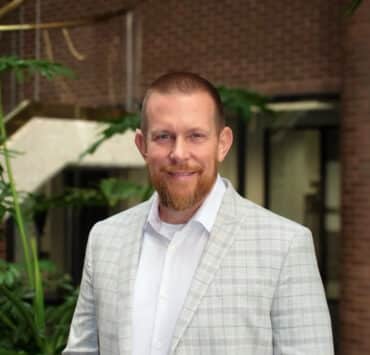|
Getting your Trinity Audio player ready...
|
As a twenty-two-year-old logistics leader in the military, Mike McCaffrey was in charge of nearly thirty troops, some of whom had been serving for as long as he had been alive. He quickly realized that he needed to lead the group with a unique approach.
“I understood that I was in charge of these folks and was responsible for their well-being, but I needed to honor and listen to their input—especially if they’d been around for a while—or else they would watch me fail,” McCaffrey says. “I had to take on a more servant-minded and collaborative leadership style and found that those working for me respected that more.”
Armed with a collaborative approach to leadership, logistics expertise, and a strong work ethic, McCaffrey transitioned out of the Army in five years and served as a logistics manager at Ryder Integrated Logistics for six years. In 2000, he brought his perspective to Apple as a global supply manager, a role that turned out to be another important milestone in his development as a leader.
Steve Jobs had returned to the organization four years prior and had breathed new life into it. To the world, Apple was thriving because of its cutting-edge products. But to McCaffrey and his colleagues, it was the vision behind such innovation that resonated.
“Jobs laid out a vision that one day we’d all have music, movies, pictures, and media in the palm of our hand and that we’d be able to stream it to our TVs,” McCaffrey says. “That really galvanized the company to bring it into fruition. It also taught me that if you have a vision, can articulate it, and get the right people behind it, it’s almost limitless in terms of opportunities. Bottom line is vision matters. It’s not just smoke and mirrors. It can actually drive an organization.”
“Supply resiliency is the keyword these days. It’s about really creating transparency through the supply chain all the way to raw materials—understanding the state of the supply chain and where soft spots currently exist.”
Mike McCaffrey
In 2004, McCaffrey got a chance to lay out a vision of his own at Oregon Health & Science University, a public academic health center in Portland, Oregon that touts highly ranked clinical and research programs and two high-performing hospitals. For the past twenty years, the vice president and chief supply chain officer has focused on elevating his department and making sure his colleagues have what they need to serve patients.
“We’ve been creating a high level of reliability in what we do so nursing staff and clinical staff can be confident that things will be there for them to do their jobs. If we’re not getting supplies to the right places at the right times, that creates challenges and can even evolve to patient risk,” he says. “Our vision has always been to have those reliable and efficient services that meet the needs of both staff and patients and fulfill our mission as a service-oriented organization.”
One way has been by transforming supply flow management in health system storerooms. By implementing PAR Excellence bin systems, the team has insight into real-time stock analytics and can fill supply orders more efficiently. The team has also collaborated with their distributor so that orders are appropriately slotted and organized upon arrival. Automation has been a key component to creating the kind of reliability and efficiency McCaffrey and his team are aiming for, he shares.
“When the PAR Excellence bins reach a minimum amount of stock, those orders are all aggregated and automatically pushed through our ERP (enterprise resource planning) system, approved in an automated way, and then show up in that organized fashion,” he says. “What this does is give our staff confidence that things will be there for them. Our goal was to take supply chain out of their roles and to make sure they’re working at the top of their game.”
The system also proved to be advantageous amid the COVID-19 pandemic and the supply chain disruptions that ensued.
“Due to the data we were collecting, we knew exactly how much inventory we had on a daily basis and how fast we were consuming it. We could quickly use that information to analyze how many days of supply we had left,” McCaffrey explains. “That gave us the ability to work with our clinical leaders to anticipate challenges and make informed decisions on how to stretch our supply, so there was never a point that a clinician was going without what they needed.”
“Bottom line is vision matters. It’s not just smoke and mirrors. It can actually drive an organization.”
Mike McCaffrey
Even so, the pandemic revealed just how sensitive supply chains can be during unpredictable events. That makes it even more important for leaders to stay prepared, McCaffrey advises.
“Supply resiliency is the keyword these days. It’s about really creating transparency through the supply chain all the way to raw materials—understanding the state of the supply chain and where soft spots currently exist,” he says. “As an industry, our ability to provide that information as early as possible is critical to avoiding situations we’ve seen. That, coupled with thoughtful planning on potential disruption events and the critical items needed, will make supply resiliency come to life.”
Backed by more than 140 years of expertise, Owens & Minor knows that the right partner is critical to building a strong, resilient, and sustainable healthcare supply chain. While the supply chain team at Oregon Health & Science University (OHSU) focused on establishing and driving a strategy that laid the foundation for future growth, the Owens & Minor team was there every step of the way, ensuring that OHSU had the visibility, transparency, and control it needed to deliver on its long-term vision.
Used by over three hundred hospitals and IDN’s, PAR’s weight-based inventory management technology and accompanying cloud-based software combine to offer clients the highest degree of inventory automation in healthcare. With over two million scales in use across ten thousand supply locations (e.g., operating rooms, cath labs, interventional radiology, laboratory, nursing, emergency rooms and non-acute settings), PAR’s scales can automate requisitions for all types of inventories in any location. As demands for supply chain performance increase and rising labor costs make hiring more challenging, hospitals are increasingly embracing PAR’s inventory automation to modernize their near-patient supply management operations for the next twenty years.

